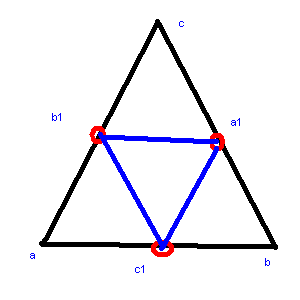hi!
i have to write a gui window, which draws sierpinskys triangle recursively, i have one main class:
package triangleMod;
import java.awt.Dimension;
import java.awt.Frame;
import java.awt.Point;
import javax.swing.JFrame;
public class Main extends Frame{
static Point a;
static Point b;
static Point c;
static Triangle tryAngle;
static JFrame frame;
private static final long serialVersionUID = 1L;
//frame setup taken from:
//http://java.sun.com/docs/books/tutorial/uiswing/examples/components/FrameDemoProject/src/components/FrameDemo.java
private static void createAndShowGUI() {
//Create and set up the window.
frame = new JFrame("Fractal: Sierpinski's Triangle");
a = new Point(0, 443);
b = new Point(512, 443);
c = new Point(256, 0);
tryAngle = new Triangle(a, b, c);
tryAngle.setPreferredSize(new Dimension(514, 446));
//frame.add(tryAngle);
frame.setDefaultCloseOperation(JFrame.EXIT_ON_CLOSE);
frame.getContentPane().add(tryAngle);
//Display the window.
frame.pack();
frame.setVisible(true);
}
public static void main(String[] args) {
//Schedule a job for the event-dispatching thread:
//creating and showing this application's GUI.
javax.swing.SwingUtilities.invokeLater(new Runnable() {
public void run() {
createAndShowGUI();
}
});
}
}AND MORE IMPORTANT: the triangle class with the recursion
package triangleMod;
import java.awt.Component;
import java.awt.Graphics;
import java.awt.Point;
class Triangle extends Component{
private static final long serialVersionUID = 1L;
//A, B, C initial triangle-points, assigned in the constructor
private Point A, B, C;
//points for the 3 new inner triangles in the current recursive step
private Point A1, B1, C1, A2, B2, C2, A3, B3, C3;
public Triangle(Point a, Point b, Point c){
this.A = a;
this.B = b;
this.C = c;
}
//helper var for recursion termination
int i= 300;
//draws fractal
public void drawFractal(Graphics g, Point a, Point b, Point c){
/**
* draw outer triangle
**/
//AB
g.drawLine(a.x, a.y, b.x, b.y);
//AC
g.drawLine(a.x, a.y, c.x, c.y);
//BC
g.drawLine(b.x, b.y, c.x, c.y);
/**
* Points of the 3 new triangles get assigned
**/
//lower left triangle coordinates
A1 = new Point(A.x, A.y);
B1 = new Point(c.x, b.y);
C1 = new Point((a.x+c.x)/2, (c.y+a.y)/2);
//lower right triangle coordinates
A2 = new Point(c.x, b.y);
B2 = new Point(B.x, B.y);
C2 = new Point((c.x+b.x)/2, (c.y+a.y)/2);
//upper triangle coordinates
A3 = new Point((a.x+c.x)/2, (c.y+a.y)/2);
B3 = new Point((c.x+b.x)/2, (c.y+a.y)/2);
C3 = new Point(C.x, C.y);
/**
* draw inner reversed triangle
**/
//AB
g.drawLine(A3.x, A3.y, B3.x, B3.y);
//AC
g.drawLine(A3.x, A3.y, A2.x, A2.y);
//BC
g.drawLine(B3.x, B3.y, A2.x, A2.y);
/**
* rekusive method calls for the three new triangles
**/
//termination condition not set correctly, helper var i used for testing
while (i-->0) {
drawFractal(g, A1, B1, C1);
//drawFractal(g, A2, B2, C2);
//drawFractal(g, A3, B3, C3);
}
}
public void paint(Graphics g){
drawFractal(g, A, B, C);
}
}THE PROBLEM:
as you see, in the whle loop i commented two of the recursive calls out, if I just have one of the 3 calls (no matter which one of the three), it works, the triangles in that direction are drawn. but if I have two or three of the recursive call, it does not work, it's not drawing the triangles i want. the three recursive calls seem to affect each other in a way i don't want.
i just don't get each of the recursive drawing just the triangles they do draw, when i just have the one recursive call in the while loop. i thought it should work, as i have separated, always newly defined points for A1, B1, C1 and so on...
maybe i am misunderstanding how the java stack recursion works, can anyone maybe test my code and give any help??
would really be cool, thx a lot
btw: i know that the condition in the while loop is not the right recirsive base condition, but i didn't think about the right one yet and just used it like it is there for testing, i want to fix that if my method principally works correct


